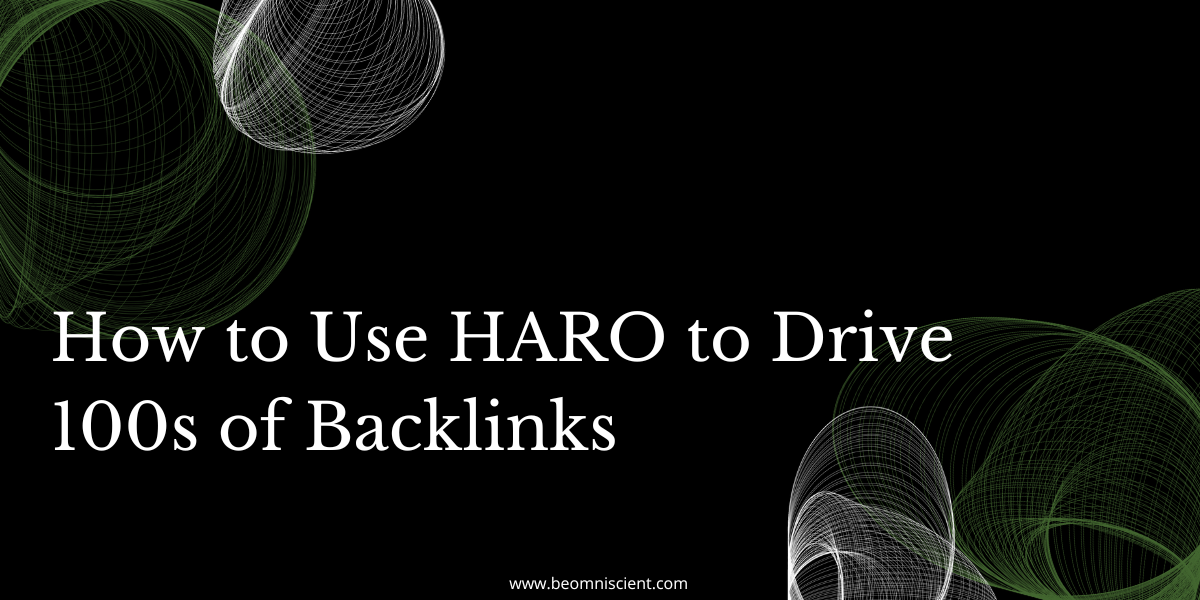
I’m a big fan of HARO (Help a Reporter Out).
It’s been a consistent part of my link building strategy since Ryan Holiday wrote about it in Trust Me I’m Lying (2012? Wow.)
For those unfamiliar, HARO is a free service that connects journalists with sources for their stories.
As a source, you can gain some valuable publicity for yourself, your blog, or your business (aka snag some sweet backlinks, baby).
What is HARO?
HARO (Help a Reporter Out) is used by journalists and bloggers to find sources for their stories, and it can be a great way to get your name out there and generate some backlinks.
Ultimately, HARO is a tool you can use to achieve your goals. In most cases, people use it as a part of their link building strategy to rank their blog posts and business higher in Google.
Others (particularly in public relations) use it to get exposure for their clients in top publications and across social media.
It’s not going to make or break any given function, and you won’t rank on Google overnight just using HARO (you also need a solid content strategy, great blog content, etc.). But it does help if you use it right.
Here’s how to use HARO to generate backlinks:
1. Sign up for a free account at Help a Reporter Out.

2. Once you’re signed up, you’ll start receiving daily emails

The Benefits of Using HARO
These daily emails are filled with HARO queries submitted by journalists looking for expert sources. Each HARO query is an opportunity for you, the expert source, to be featured in their story.
Not all publications are great, but sometimes you can find placement opportunities at top publications like the New York Times. This can do wonders for your brand, public image, industry reputation, press relations, and of course, ability to rank content in Google and other search engines (good links increase the authority of your site).
It’s worth perusing the daily emails to see if there are any opportunities to work with great journalists. Just a few minutes of your time spent responding to journalists can go a long way in getting them to write about you. The platform is super intuitive and easy to use.
It’s that simple to get started using HARO.
Alright, enough about the benefits of using HARO. I think those are apparent, especially if you’ve been working in marketing or SEO long enough.
For the rest of this article, I’m going to show you how to use HARO to generate backlinks for your website.
How to Use HARO to Generate Backlinks
HARO is a great way to get links to your website. But before you start submitting pitches, there are a few things you need to do:
1. Sign up for an account.
You can sign up for a free account on the HARO website. Once you have an account, you’ll be able to access the reporter queries.
It’s super easy to sign up. Either sign up as a “Source” (someone who responds to HARO queries) or a Journalist (someone who submits queries for their stories):
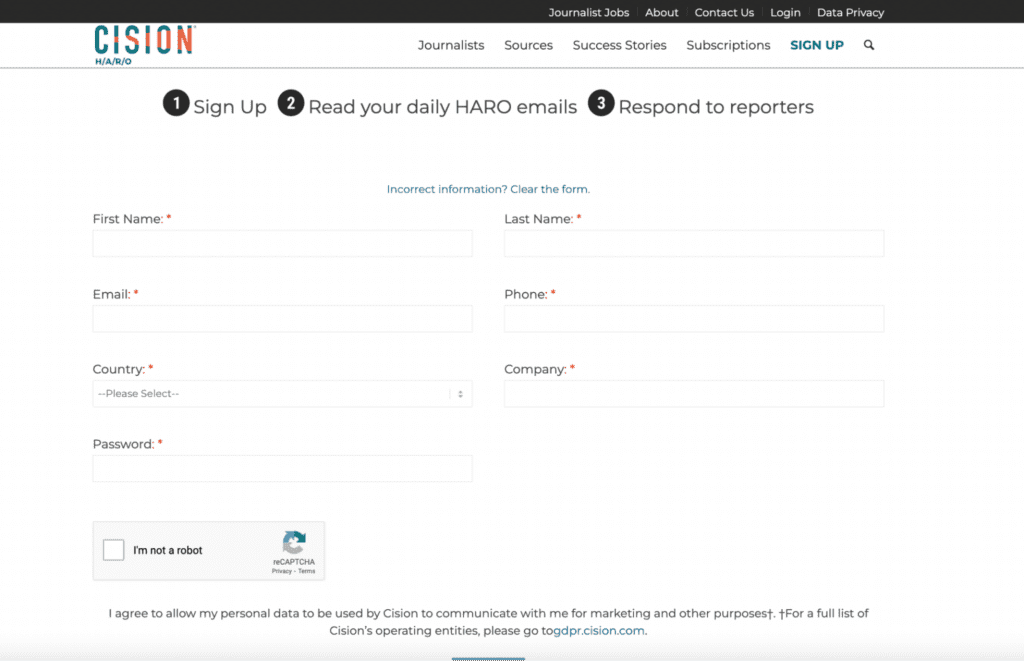
2. Familiarize yourself with the types of queries being sent out.
There are three different types of queries that reporters send out:
- Request for information: These are general questions that reporters are looking to have answered by experts in a particular field.
- Request for quotes: These are specific questions that reporters are looking for quotes on from sources in a particular field.
- Request for interview: These are requests from reporters looking to interview someone with expertise in a particular field.
Most HARO queries are simple requests for quotes and information. You can just respond with a quick sound bite, your information (headshot, bio, link to your company website), and you’ll get a link if chosen.
Some, however, are requests for deeper interviews. For example, this one is seeking audiologists for a deeper interview to get on Forbes Health:

You can pick your areas of expertise when signing up. Most of the time, it’s obvious.
This one, for example, is just looking for 2-3 quick tips.

3. Find relevant queries and pitch yourself as a source.
Once you know what kind of queries reporters are sending out, you can start pitching yourself as a source.
When you find a query that’s relevant to your area of expertise, simply send an email to the reporter with your answer or quote.
What makes a good quote? I’ll cover that in more detail in the “examples” section below, but a few quick tips:
- It should pique attention. Basic / boring answers and tips don’t work well.
- Short and to the point. Don’t ramble. Be concise. Make it scannable.
- Add actual value through expertise. If you’re not an expert, don’t send a quote.
- There are many HARO PR agencies. Most don’t do as well as you could by just answering yourself.
Include your name, title, and contact information so the reporter can follow up with you if they’re interested in using your response in their story.
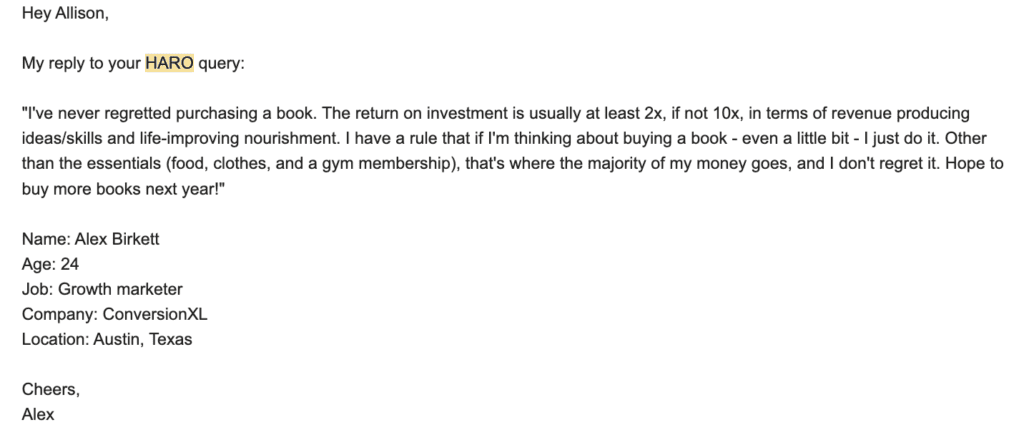
A few more best practices on responding to HARO queries:
Research the publication thoroughly before responding.
It’s usually apparent, after viewing a few published articles, what journalists are looking for in a response. Couple that with the obvious intelligence you can gather from your query, and you can optimize your HARO sends to get a response and ensure a placement and link building success.
Include your basic info
I’ve gotten great responses, but without adequate personal information, it’s hard to follow up and build a relationship.
Make sure you drop your name, title, company, URL, and a headshot. This makes it easy to contextualize your HARO sends and place it easier. You want to make the job as easy as possible for the journalist.
Link building is a long game
Your goal should be to provide a value response to the query. If you pass that bar, you capture the attention of the journalist or blogger.
From there, you have a great chance of getting a link. But that’s just one link.
It’s more than likely the journalist a) will write more articles and need more subject matter expertise and b) will write articles for additional publications.
Your goal should be to build a relationship that lasts longer than this single HARO query.
4. Follow up after the story is published.
If you’re lucky enough to have your response used in a story, make sure to follow up with the reporter after it’s published.
Thank them for featuring you and let them know that you’re available as a source for future stories.
This is also a good time to ask for a link back to your website if one wasn’t already included in the story.
It’s also the best way to build a rolodex of media contacts so you don’t have to cold pitch someone every time you want to get a quote or link placed.
I’ve actually met some great friends through pitching HARO quotes.
3 Effective HARO Pitch Examples
I’ve been on both ends of the HARO marketplace: I’ve used it as a content marketer / journalist to get quotes for my stories, and I’ve gotten links placed as a source.
So I know a little bit about what works and what doesn’t.
Here’s the key to creating an effective HARO pitch: objectively add value, and make it short, sweet, and to the point.
Reporters are often inundated with pitches, so you want to make sure yours stands out.
Here are a few examples of effective HARO pitches:
1. My pitch at LawnStarter
Back when I worked at LawnStarter, I got quotes for myself as well as the co-founders of the company.
It’s easier to pitch yourself, but if you’re going to pitch for someone else, add the quotes directly into the pitch. Don’t just send a reply and offer to introduce the journalist. That’s a lot of work. You want to cut out all the work necessary and only THEN offer to introduce the two parties:
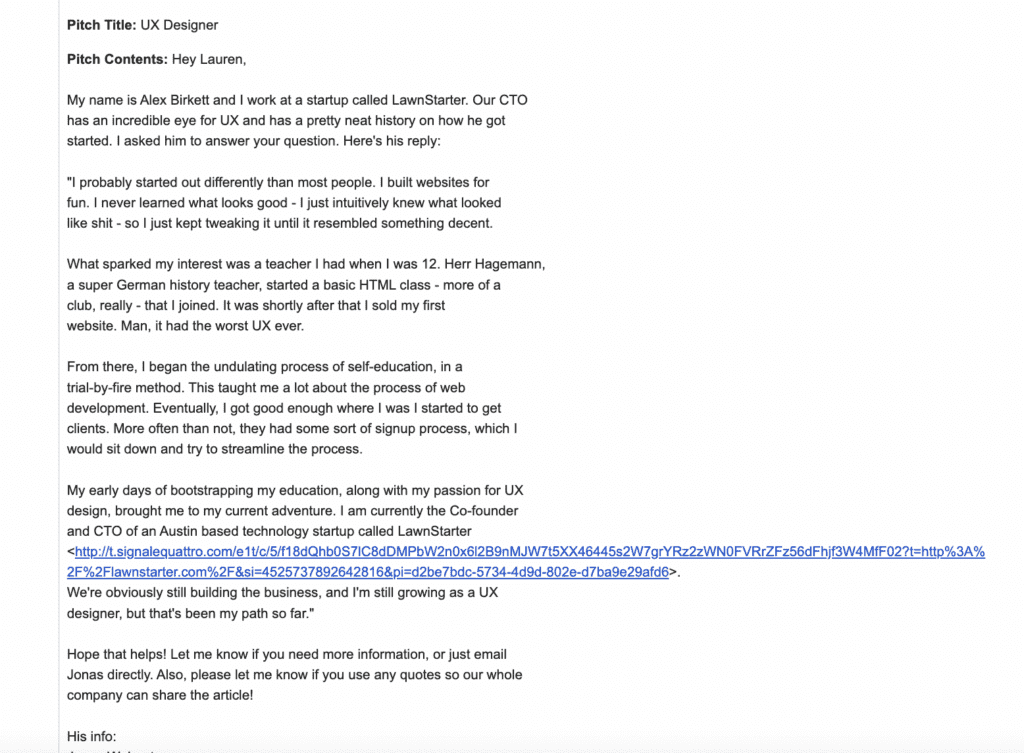
Other things: I didn’t make the brand the main subject of my response. I know not to respond with anything overly promotional, lest it gets ignored. Contributing a valuable response is the most important thing you can do to get featured.
2. Colin M. Darretta’s pitch
I know this breaks a few of my rules (short and to the point), but Colin added so much context and value that it was easy for me to pull some quotes right away for my article.
I eventually followed up for more details, but he gave me so much transparent and authentic information for my piece that it was easy to work with:
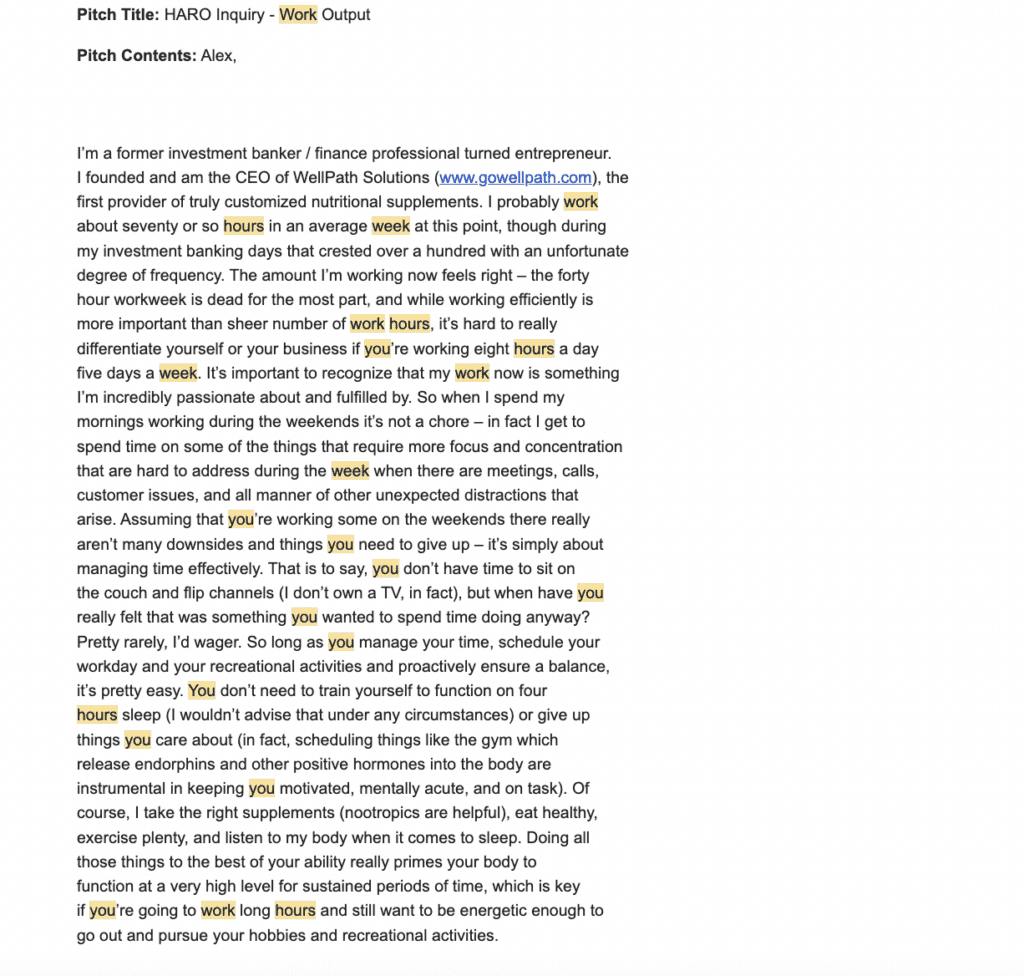
The other thing to note here is that Colin is submitted for himself, not on behalf of someone else.
My HARO query was about “people who work long work hours,” and in this context, I definitely loved hearing from business owners themselves.
Also, Colin’s response was incredibly valuable and didn’t center on the subject of his brand. His HARO response shows that he understands the platform well (and I included him in the eventual blog post).
3. Molly St. Louis’s follow up
Like I mentioned above, it’s best practice to follow up after your quote goes live and thank the journalist.
You can see here that Molly thanked me for including her quote and then referenced her desire to work with me on future stories. And we did work together on future stories.
This is a great way to build relationships in the media space. Here’s the image of her follow up:
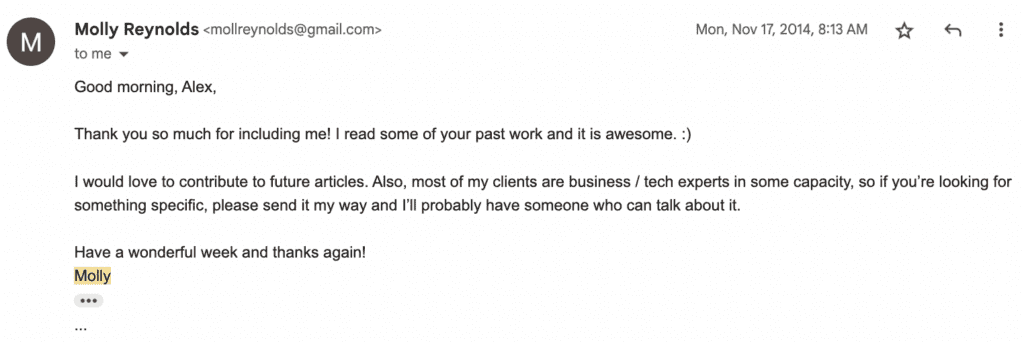
While I didn’t show her initial answer, that was high quality and valuable as well (obviously – otherwise I wouldn’t have spent time responding and including her answer in the blog post).
But the biggest benefits of the platform may come from the lasting connection and future collaboration potential.
For instance, I can contact Molly now anytime I have a story related to her or her clients. Bloggers always need a good subject to include in their stories. And on the source side, marketing is best thought of as a continuing effort, not a one off response.
Molly is, herself, a journalist, so she clearly understands not only how the HARO platform works, but how to build relationships with writers and journalists to create a quality relationship being the initial blog post. We went on to work together on many different articles and projects.
Conclusion
HARO is a solid way to build backlinks. It’s diminished in quality since the early days, but even in 2023 and beyond, it’s still effective for scaled out link building and digital PR.
There are now several alternatives for specific niches. For example, there’s a Help a B2B Writer Out service now that we use a lot.
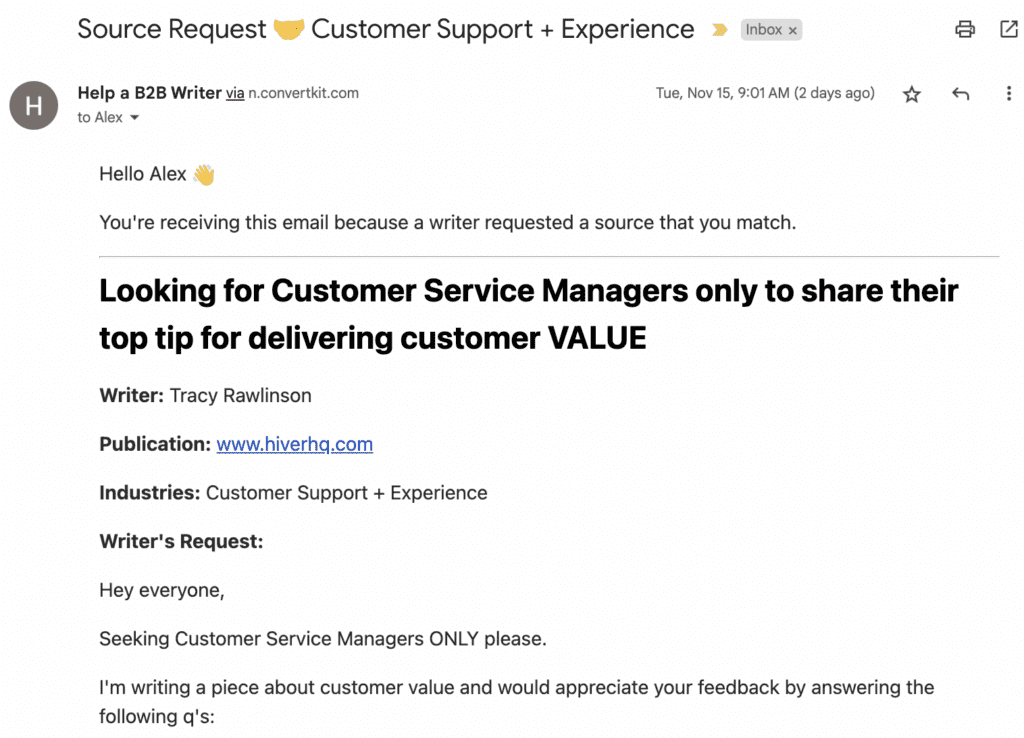
Companies are also building their own internal HAROs. For example, Databox has a list of trusted sources they pull quotes from regularly.

In any case, if you’re an expert in a given field, it’s incredibly easy to land links if the journalist is directly asking for a quote.
Your marketing / business / brand / link building plan should include more than just responding to HARO queries, but you might as well be the person they choose to showcase. Journalists and bloggers are already using it. You might as well use HARO, too.
By following these tips, you can use HARO to generate backlinks for your website and improve your SEO in the process. Good luck responding to HARO queries!



